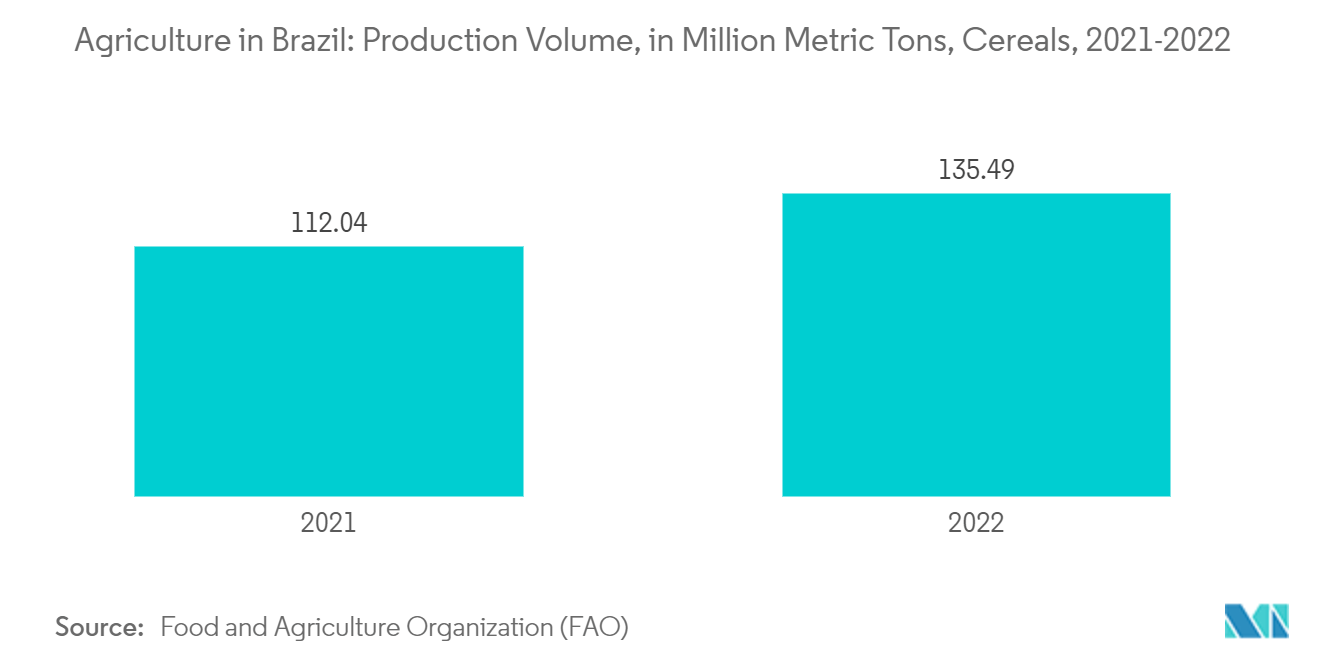Market Trends of Agriculture In Brazil
Increasing Food Crop Production
Brazil's major crop-producing regions, including Rio Grande do Sul, Santa Catarina, and Parana, have a climate suitable for rainfed crop production. Dominating the agricultural landscape, soybean, maize, sugarcane, and rice comprise 90% of the country's total crop area, solidifying Brazil's status as a leading global producer and exporter of these staples.
As per a USDA report, in 2021, Brazil stood as the world's second-largest producer of biotech crops, with 115 approved events. The USDA's Post projects that in the concluded 2020-2021 crop year, over 56 million hectares were dedicated to genetically engineered (GE) crops. Adoption rates are notably high: 98% for soybeans, 88% for corn, and 80% for cotton. In 2021, data from the Brazilian government revealed a 70% increase in average yields for grains and oilseeds over the past 15 years, with a significant portion of this growth credited to the adoption of biotechnology seeds.
For the 2021-2022 crop season, the Brazilian government unveiled a total fund of BRL 251.2 billion (USD 461 million) to support farmers. This marks a 6.3% increase from the previous Safra Plan. BRL 73.44 billion (USD 142 million) is earmarked for investments, reflecting a substantial 29% rise from the 2020-2021 Safra Plan.
Brazil's diverse climates enable the cultivation of a wide array of fruits, including tropical varieties like mangoes, melons, and grapes. Leveraging advanced agricultural technologies, such as irrigation systems, Brazilian fruit farmers consistently meet and often surpass international quality benchmarks. Data from the Brazilian Association of Fruit Producers and Exporters (ABRAFRUTAS) indicated a 6% increase in export volume and a 26.7% increase in export value in 2023. This growth of 1.085 million tons of fruit has penetrated several discerning international markets. Consequently, Brazil is the third-largest fruit producer globally, trailing only behind dominant exporters China and India, suggesting a burgeoning market demand in the review period.

Growing Trade Opportunities
Brazil has been enhancing its commodity exports to numerous countries. As one of the top producers of agricultural and food products, Brazil leads in oilseed production, particularly soybeans. While Brazil is a dominant player in corn and soybean exports, its fruit exports are also rising. Benefiting from a favorable climate, Brazil has bolstered its supply, enabling it to meet shipment demands from various nations. The country has consistently excelled in commodity exports. The trend holds for fresh fruits, with Brazil setting records for several key exports. In 2023, Brazil's primary fruit exports included lemons, limes, papayas, mangos, watermelons, and melons. According to a USDA report, fresh orange imports reached 32,000 metric tons in 2023, marking a 6.25% rise from the 30,000 metric tons imported the previous year.
These rising export figures underscore a robust demand for Brazilian products. Data from the Secretariat of Foreign Trade (Secex) reveals that exports in August 2023 surged to around 5,910 metric tons, a 454% increase from the previous year. In August, the United Kingdom emerged as the top destination, accounting for 48% of the total exports, followed closely by the Netherlands at 41%.
Data from ITC Trademap indicates that in 2023, Brazil's Apples, pears, and quinces fruit exports, valued at USD 30,783 thousand, primarily reached European nations like the Netherlands, the United Kingdom, Spain, and France, which is higher than the previous year accounted with USD 24,785 thousand. Given this trajectory, the burgeoning export market is poised to invigorate Brazil's domestic agricultural production further, propelling the overall market growth.


